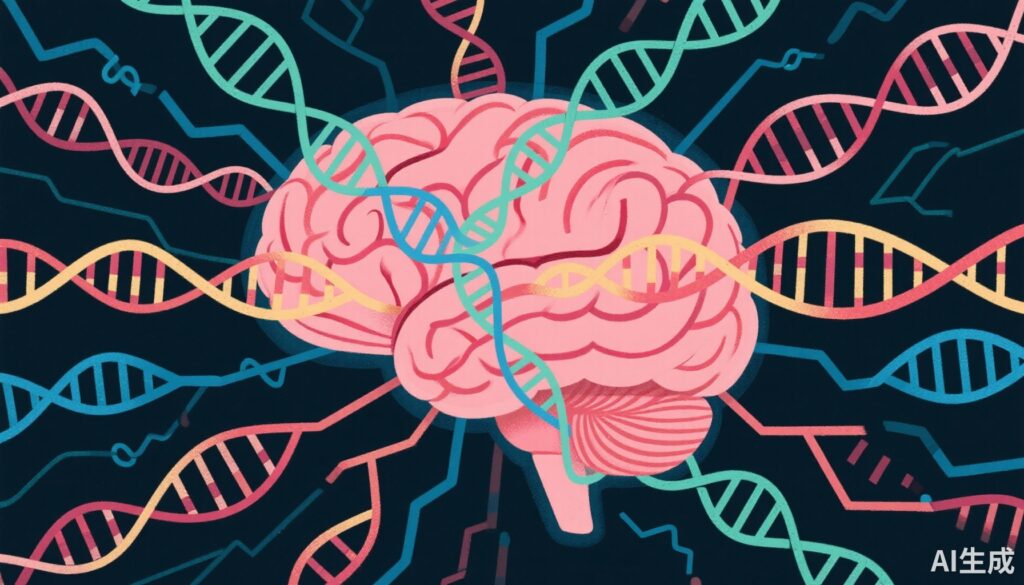Highlight
This genetically informed study elucidates substantial polygenic overlap between problematic alcohol use (PAU) and multiple psychiatric disorders, revealing shared genomic regions and candidate causal genes such as TTC12 and ANKK1. Findings emphasize complex shared genetic etiologies influencing comorbidity, with replication across multiple ancestries.
Study Background
Problematic alcohol use (PAU) significantly worsens clinical outcomes for patients with psychiatric disorders, complicating diagnosis, treatment response, and prognosis. Clinical comorbidity between PAU and psychiatric conditions such as major depression and schizophrenia is well documented, but the biological mechanisms driving this overlap remain incompletely understood. Emerging evidence from genome-wide association studies (GWAS) suggests that shared genetic factors contribute to the co-occurrence of PAU and psychiatric illnesses. Unraveling these common genetic architectures can illuminate pathophysiological pathways and identify targets for more precise therapeutic interventions.
Study Design
This study leveraged extensive GWAS summary data from 435,563 individuals of European ancestry characterized for PAU. The authors investigated the genetic overlap between PAU and 11 psychiatric disorders using advanced statistical methods. The bivariate causal mixture model (MiXeR) quantified polygenic overlap, while local genetic correlation and colocalization analyses pinpointed genomic loci with shared associations. Further analyses included conjunctional false discovery rate (FDR) adjustment and transcriptome-wide association studies (TWAS) integrating brain transcriptomic data. Summary-data-based Mendelian randomization (SMR) approaches prioritized putative causal shared genes. Multi-ancestry validation ensured robustness.
Key Findings
Substantial Polygenic Overlap: The MiXeR model demonstrated a significant polygenic overlap between PAU and psychiatric disorders, ranging from 39% to 73%. This indicates that a considerable proportion of genetic variants influence liability to both PAU and psychiatric conditions simultaneously.
Shared Genomic Regions and Correlations: Four bivariate genomic regions exhibited high local genetic correlations, suggestive of shared causal variants. Notably, these regions were implicated in the PAU-major depression and PAU-schizophrenia pairs, underlining possible common pathophysiological hubs.
Identification of Shared Genes: Conjunctional FDR analysis mapped four genes for the PAU-major depression axis and six genes for PAU-schizophrenia within the shared loci. Among these, TTC12 and ANKK1 emerged as prominent candidate genes potentially causally linked to both PAU and psychiatric disorders. These genes are located near the dopamine receptor gene DRD2, which is well recognized for its role in addiction and neuropsychiatric phenotypes.
Replication and Cross-Population Validation: The identified genetic overlaps and candidate genes were corroborated through colocalization and TWAS analyses across diverse ancestries, strengthening the generalizability of the findings.
Expert Commentary
The demonstration of high polygenic overlap supports the hypothesis that genetic liabilities shared between PAU and psychiatric disorders contribute to their clinical comorbidity. The involvement of TTC12 and ANKK1 near DRD2 aligns with neurobiological models highlighting dopaminergic signaling pathways in addiction and mental illnesses such as schizophrenia and depression. The use of complementary integrative methodologies, including MiXeR, colocalization, TWAS, and Mendelian randomization, provides a rigorous multidimensional genetic perspective.
However, limitations include the predominantly European ancestry of the primary GWAS datasets, which may limit direct extrapolation to other populations despite attempts at multi-ancestry replication. Moreover, the observational nature of genetic correlations cannot definitively prove causality or elucidate mechanistic pathways without functional validation. Future studies incorporating longitudinal clinical data, multi-omic layers, and experimental models will be crucial.
Conclusion
This comprehensive genomic study highlights significant shared genetic architectures underlying PAU and a broad spectrum of psychiatric disorders, with particular emphasis on major depression and schizophrenia. The identification of genes such as TTC12 and ANKK1 near the dopamine receptor locus DRD2 advances our understanding of the molecular genetic basis of comorbidity. These findings have important implications for refining psychiatric nosology, risk prediction, and developing targeted therapeutic strategies addressing overlapping neurobiological substrates.
Further research integrating functional genomics and clinical phenotyping will be vital to translate these genetic insights into improved outcomes for individuals facing the dual challenges of psychiatric illness and problematic alcohol use.
Funding and ClinicalTrials.gov
Details on funding sources and clinical trial registration numbers were not provided in the original publication summary.
References
Ahn Y, Kim J, Jung K, Lee DJ, Jung JY, Eom Y, Park S, Kim J, Kim H, Jo H, Hong S, O’Connell KS, Andreassen OA, Myung W, Won HH. Relationship Between Problematic Alcohol Use and Various Psychiatric Disorders: A Genetically Informed Study. Am J Psychiatry. 2025 Jul 1;182(7):671-682. doi: 10.1176/appi.ajp.20240095. Epub 2025 May 7. PMID: 40329641.



